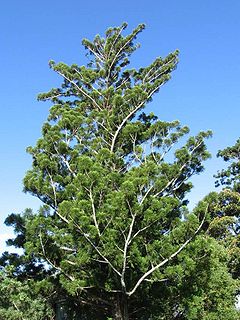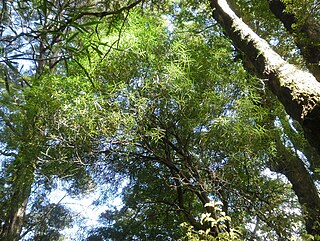Ironwood is a common name for many woods or plants that have a reputation for hardness, or specifically a wood density that is heavier than water, although usage of the name ironwood in English may or may not indicate a tree that yields such heavy wood.

Olea is a genus of about 40 species in the family Oleaceae, native to warm temperate and tropical regions of the Middle East, southern Europe, Africa, southern Asia, and Australasia. They are evergreen trees and shrubs, with small, opposite, entire leaves. The fruit is a drupe. Leaves of Olea contain trichosclereids.

Araucaria cunninghamii is a species of Araucaria known as hoop pine. Other less commonly used names include colonial pine, Queensland pine, Dorrigo pine, Moreton Bay pine and Richmond River pine. The scientific name honours the botanist and explorer Allan Cunningham, who collected the first specimens in the 1820s.

Nothofagus cunninghamii, the myrtle beech, is an evergreen tree native to Tasmania and Victoria, Australia. It grows mainly in the temperate rainforests, but also grows in alpine areas. It is not related to the Myrtle family. It is often referred to as Tasmanian myrtle within the timber industry. N. cunninghamii was proposed to be renamed Lophozonia cunninghamii in 2013. There has been some controversy over the change in name from Nothofagus to Lophozonia.

The hairpin banksia is a species of woody shrub, of the genus Banksia in the family Proteaceae, native to eastern Australia. Widely distributed, it is found as an understorey plant in open dry forest or heathland from Victoria to northern Queensland, generally on sandstone though sometimes also clay soils. It generally grows as a small shrub to 2 metres (7 ft) in height, though can be a straggly tree to 6 metres (20 ft). It has long narrow leaves with inflorescences which can vary considerably in coloration; while the spikes are gold or less commonly yellowish, the emergent styles may be a wide range of colours – from black, purple, red, orange or yellow.

Alsophila cunninghamii, synonym Cyathea cunninghamii, also known as the gully tree fern and slender tree fern, is a species of tree fern indigenous to New Zealand including North Island, South Island and Chatham Islands; also to Victoria, possibly New South Wales, southeastern Queensland and Tasmania in Australia. It grows in damp forest, often emerging from stream gullies and riverbanks. Brownsey noted that it has a lower tolerance for drought than other related species. The erect trunk may be 20 m tall and is usually 6–15 cm in diameter, occasionally as much as 20 cm. Fronds are tri- to tetrapinnate and 3 m or more in length. The rachis and stipe are slender, black brown, warty and covered with brown scales. Sori occur along each side of the pinnule midvein and are covered by hood-like indusia. A. cunninghamii is an uncommon and slow-growing tree fern.
Alsophila × marcescens, synonym Cyathea × marcescens, commonly known as the skirted tree fern, is a tree fern endemic to the Cape Otway ranges in Victoria and Tasmania, Australia. It is a natural hybrid, apparently Alsophila australis × Alsophila cunninghamii. Large and Braggins (2004) note that it has characteristics midway between these two species. The spores of A. × marcescens are usually malformed although sterile. The trunk of this plant is erect and up to 10 m tall. Fronds may be bi- or tripinnate and 3–4 m in length. Dead fronds often persist, forming a characteristic skirt around the trunk. The stipe is thick, black and warty. The rachis and trunk are covered in shiny, dark brown scales. Sori are borne near the fertile pinnule midvein and are protected by thin indusia that are saucer-like in appearance.

Syzygium maire, swamp maire, is an evergreen tree endemic to New Zealand. It is found throughout the North Island, and the top of the South Island. The Māori language name is maire tawake. Swamp maire grows in wetlands, where it develops breathing roots in waterlogged soils, but is also tolerant of reasonably dry situations. The creamy-white flowers in autumn are followed by bright red drupes around 3 cm in length in late winter. The fruit are edible and can be eaten raw or cooked. The fruits are rich in antioxidants. Swamp maire is sold for use in gardens as an ornamental plant. It is not related to other species called maire, which are in the genus Nestegis.

Nestegis apetala is a small tree native to northern New Zealand and to Norfolk Island. The common names in New Zealand are coastal maire or broad-leaved maire. On Norfolk Island, the common name is ironwood. The species name apetala refers to the lack of petals on the flowers.

Nestegis is a genus of flowering plant in the olive family, Oleaceae. There are five currently accepted species in the genus: three species are endemic to New Zealand, while one can be found on New Zealand and Norfolk Island. Another is restricted to Hawaiʻi.

Banksia neoanglica, commonly known as New England banksia is a shrub or small tree with leaves that are greenish on the upper surface, whitish with soft hairs on the lower side and spikes of flowers with styles that turn black as they open. It is similar to Banksia spinulosa and was formerly known as Banksia spinulosa var. neoanglica, but differs in that its leaves are wider and have margins that are not tightly turned under. It is found mainly along the eastern edge of the Great Dividing Range.

Polyosma cunninghamii, known as the featherwood, is a small rainforest tree of eastern Australia. It grows in many different types of rainforest, however seldom found in the drier rainforests. It is often seen in the cooler rainforests at high altitude. The range of natural distribution is from Kioloa near Batemans Bay in southern New South Wales, to Maleny in south eastern Queensland.

The Constellation Cup is contested by the Australian national netball team and the New Zealand national netball team. It is awarded each year to the team that wins the most test matches between the two, excluding games played as part of multinational tournaments such as the Netball World Championships and Commonwealth Games.

Persoonia myrtilloides, commonly known as myrtle geebung, is a plant in the family Proteaceae and is endemic to New South Wales. It is an erect to spreading shrub with elliptic to egg-shaped leaves and yellow flowers in groups of up to forty on a rachis up to 170 mm (6.7 in) long.

Nestegis lanceolata, commonly called white maire, is a tree native to New Zealand.

Nestegis montana, commonly called narrow-leaved maire, is a tree native to New Zealand.

Lysiphyllum cunninghamii is a species of plant in the family Fabaceae. It is native to northern Australia where it occurs from Western Australia through the Northern Territory to Queensland.

Trochocarpa cunninghamii is a flowering plant species of the family Ericaceae. It is commonly referred to as straggling purpleberry due to its round flattened mauve drupe fruits. This woody shrub is usually found in the understorey of rainforests and subalpine forests in the Central Plateau and western Tasmania, and is endemic to Tasmania.
















